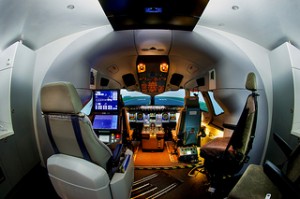Simulation refers to the imitation of real-world activities and processes in a safe environment. Simulations aim to provide an experience as close to the ‘real thing’ as possible; however, a simulated activity has the advantage of allowing learners to ‘reset’ the scenario and try alternative strategies and approaches. This allows learners to develop experience of specific situations by applying their wider learning and knowledge.
The approach is frequently used in disciplines where students need to develop skills and experience but safety issues or cost considerations prevent this happening in the real-world. For example, medical simulators allow students to practice diagnosis and treatment on dummies that can react in sophisticated and fairly realistic ways; whereas, trainee pilots (and aeronautical engineering students) use flight simulators to learn how an aircraft would react in a variety of conditions without ever leaving the ground. However, while the use of simulation is obvious and well established in these areas, it does exist in others, such as the ‘moot’ or simulated courtroom in Law, and could be applied in still more. In some disciplines, the difference between a simulation and a role-play exercise may be negligible, particularly where the exercise is focused on interactions between people.
How it Works
Simulation is a very general and flexible teaching approach that can be used in most disciplines, but this means that how it is implemented will vary greatly. The key to simulation is that it is a dynamic rather than fixed experience, with the scenario changing realistically according to the actions of the participants and the participants adapting as a result of changes to the scenario – in a sense, a simulation is a mechanism for learners to obtain real-time feedback on their actions. For example, an exercise for software engineering students could involve the creation of a piece of software or system according to a realistic design specification, with changes and refinements being requested by the client (played by the tutor) during the process. This would accurately model the real-world environment the students are likely to work in, where clients change their requirements and priorities during a project as a result of complex factors. A similar exercise would also work well in other disciplines that involve the creation of artefacts for clients, such as graphic design, architecture, contract law, etc. For a simulation exercise to be successful, it is essential that the scenario reflect actual practice and genuine situations as closely as possible. Therefore, an exercise for journalism students might be write a blog article or web page for a breaking story, using social media to conduct some of the research – reflecting the types of activities and tools encountered by professional journalists today.
The approach is often used in ‘real-time’, with participants fully immersed in the scenario for a period of time. However, it is possible to slow down or speed up the scenario, if appropriate. This could happen in situations where, in reality, a series of decisions need to be made rapidly and the students need to be given time to contemplate each decision, or where a very slow process is being simulated and there would be lots of time waiting for the effects of each decision to appear. Being able to adjust the timescale of the simulation allows students to make more considered decisions, reflect on their choices and analyse the results in greater detail than would be possible in a fast, real-time situation.
Possible Technologies to Support the Approach
The tools and technologies that would be suitable for a simulation exercise strongly depend on the situation or scenario that is being simulated. As the goal is to model the real-world as closely as possible it may be necessary to have specialist equipment and spaces available, but many situations may not require anything other than the software and other tools that students are already using. Where students are using standard software packages as part of the simulation, screen recording software provides a mechanism to capture the details of how they approached the scenario. These recordings could be submitted by the student as part of an assessment or used as the basis for reflection on their particular approach prior to re-running the simulated scenario.
In addition to enabling students to develop experience in dangerous, expensive and rare situations, simulations using technology can provide a way to relieve pressure on resources. For example, the forensic science department at SHU makes use of simulated crime scenes in the ‘Forensic House’ on the main campus, however the physical constraints mean that only a handful of students can be in the space at the same time and the time to ‘reset’ the simulation between students is quite high. A mobile app was created that allows anyone to work through different scenarios at any time, allowing the students to gain experience in investigating a realistic crime scene when and where it suits them. Apps such as this require a significant amount of development, however they provide an engaging and immersive experience for the students and there may already be freely available examples in the Apple, Android or Microsoft app stores that could be used rather than creating a new one.
Getting Started
If you are interested in trying out Simulation there are a few practical questions that you should answer:
- Where in the course/module would this approach work best?
- What situations would the student benefit from being able to explore in a controlled environment?
- What timescale should be used? Real-time? Faster? Slower?
- How much technology should be involved? Which tools are most suited? What support would be needed?
- Are the students (and other tutors) ready for this?
Having thought about these questions, you should have worked out whether Simulation is an approach that makes sense in your context and have some ideas about how to introduce it. If you are still unsure, you could try a small exercise and see how the students respond.
Further Resources
Case studies from SHU:
The following links are to case studies showing how staff at SHU have used Simulation ideas in their teaching:
- Using simulation in clinical education – London Deanery
- Computer simulations can be as effective as direct observation at teaching students – Ohio State University
- A cross-faculty simulation model for authentic learning – Diamond, S., Middleton, A. and Mather, R.
Related ‘Teaching Nuggets’:
The following link provides further information on some activities and assessment outputs that can work well with Simulation, especially for students who are part-time or not campus-based:
Other resources:
- Teaching Approaches Menu – Sheffield Hallam University





I am a strong advocate for simulation learning. I believe that it actively engages the learner within their own learning process and provides them an avenue of reflection. But how beneficial is it to ESL (English second language) students and what are other disadvantages of simulation training?
Thanks for your comments and questions, Angelia. I’m not an expert on ESL, or language learning generally, but I can see some ways in which simulation could be used to support learning in this subjects. Role-play can be seen as a loose kind of simulation and is often used in language learning to allow learners to put their skills to use, explore the limits of their learning in a somewhat realistic situation, and then use their performance as the basis of reflection. I think that the big difference between this role-play and simulation for language learners is the ability to repeat the experience exactly until such a point where the learner wants to take the experience in a new direction, such as by changing their actions in order to move a conversation in a new direction. I think that the virtual reality systems that are starting to appear, such as Google’s Cardboard or Samsung’s Gear VR, signal developments that will eventually lead to extremely immersive, simulated learning experiences, such as being in (non-existent) café chatting to a (non-existent) local and coming out of it feeling like you really were there. Similarly, many classrooms could be fairly easily adapted into a good simulation environment for people to learn business English by setting up the tables similar to a meeting room or by setting out computers for people to work through a simulated email conversation.
As for disadvantages, I think that a potential disadvantage for simulation is that it could over-train people for certain situations, so that they are not really thinking when in a particular situation and are instead going through a ‘script’ that they have learned. This means that they may not be able to adapt effectively to situations that deviate from those they experienced during simulations. So a trainee nurse may respond inappropriately, or not quickly enough at least, to a change in a patient’s condition because he has never encountered the situation during a simulation and he now has to break out of that training; or the language learner may struggle when a conversation, book, email, or letter abruptly changes direction into something tangential that she has not experienced in a simulation of this situation. I suppose that the way to mitigate the problem of over-training is to ensure that over the course of multiple simulated sessions some of these outlier situations do happen.
The other major disadvantage to simulation training is that for it to be as effective as possible, it needs to be as realistic as possible. So, for language learning, you would want the learners to be interacting with native speakers rather than other learners, which would probably be fine for role-play activities, and would want the environment to model that of where the simulation is taking place too. Both of these things offer significant logistical challenges, but as I said earlier, some of the virtual reality tools being released now are likely to address the problem of environment in the near future and the internet offers a great way for learners to interact with native speakers.
I hope that goes at least some way to addressing your questions, Angelia.
Good Day Ian,
Thank you very much for your response. You provided insight to the perspective that I never would have thought about. I have been reading research studies on simulation and there is not much discussed about the disadvantages. You convey a very important point when it comes to the learners being over trained. I will continue to peruse studies to look for more disadvantages.
Angelia Fisher